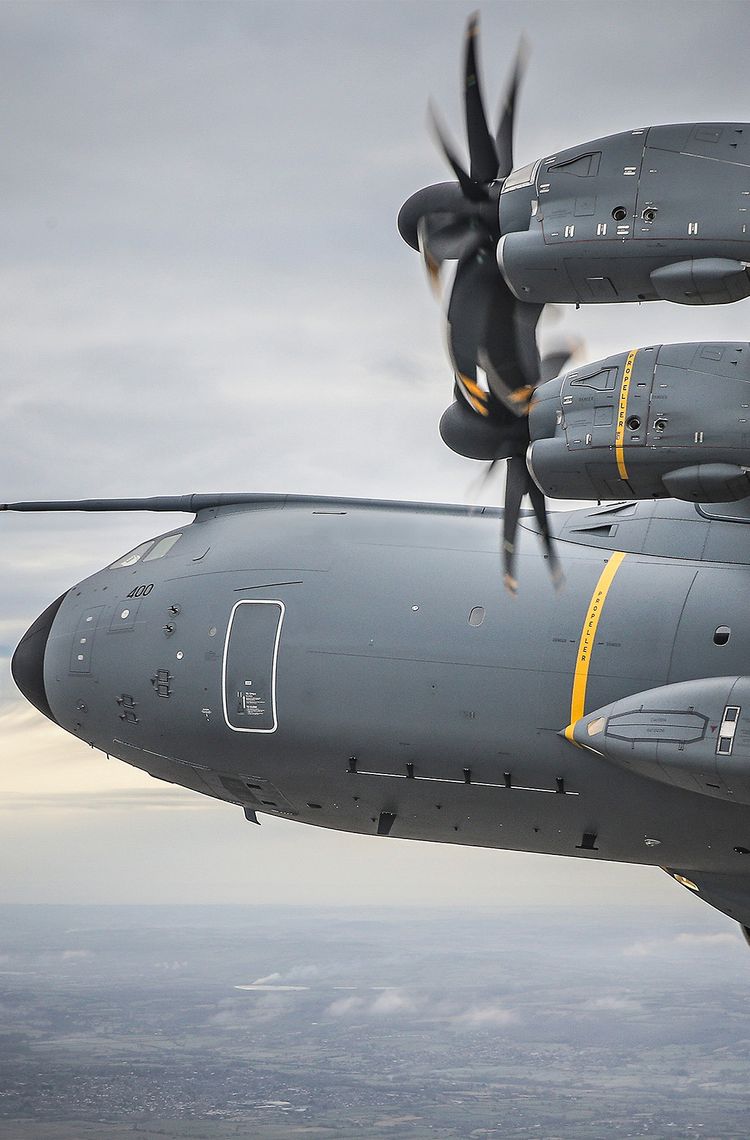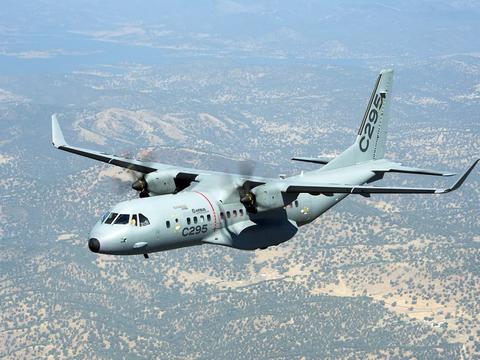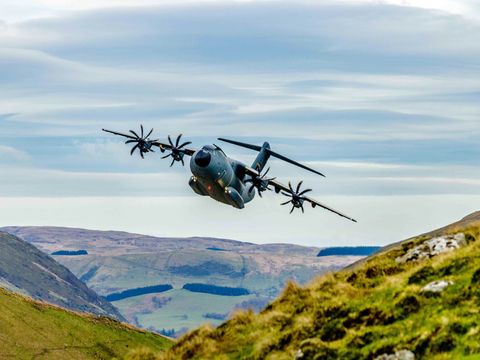In view of increasingly demanding missions, the A400M's capabilities are constantly being expanded. What are the current considerations for the aircraft’s long-term development?
No matter how advanced an aircraft programme might be, they need to evolve to keep up with the times. This also applies to the A400M. As a highly capable and versatile aircraft, it must operate effectively in the most challenging scenarios, both now and in the future. Consequently, Airbus Defence and Space, in collaboration with its partners and suppliers, is committed to the ongoing development of the A400M. What are some of the key topics currently on the agenda?
Connecting today and tomorrow
Effective communication is an essential part of military operations, but it is also undergoing radical change. Connectivity is paramount, with data playing an ever more important role. Looking ahead, the Future Combat Air System (FCAS) will link together various platforms from 2040 onwards, enabling the seamless exchange of critical mission information.
At the heart of FCAS lies the Combat Cloud. This is where critical data comes together, is analysed and then disseminated. All of this requires a quick data exchange. Without it, responding promptly and effectively to complex situations would be impossible.
In the context of connectivity, the A400M could act as a communications hub, distributing information to other airborne and ground-based systems. As a military aircraft with civil certification, the A400M is equipped with encrypted radio systems and the communication tools of passenger aircraft. All of these fall under the category of narrowband communications, which operate at low data rates as they are primarily designed to transmit voice and basic data.
In the future, the A400M will need to switch to broadband to leverage higher data rates. A broadband satellite connection would then enable the aircraft to send and receive large amounts of data from anywhere in the world. In the event of disrupted satellite communication, a line-of-sight system would facilitate communication along a direct sightline with other platforms in the air or on the ground.
Thanks to the higher bandwidth, one could envisage the A400M transmitting live video feeds from missions to the cloud, providing visual support for mission-critical decisions. Analysing data collected from different platforms could, in turn, enable tactical decisions almost in real time.

The Future Combat Air System will comprise manned and unmanned systems that are in constant communication with each other.
A mothership for drones
Unmanned aerial systems are already a central component of military operations. And they will only become more important in the future, contributing to mission success in close cooperation with pilots.
As a transport aircraft, the A400M could play a central role, bringing unmanned platforms, so-called Remote Carriers, as close as possible to the theatre of operations and commanding them if needed. Thanks to its large payload and range, the A400M could deploy up to 50 small or 12 heavy Remote Carriers.
The seamless integration of manned and unmanned systems is a key component of FCAS. However, the A400M could take on the role of a mothership for drones even earlier than that. Tests are already underway: At the end of 2022, Airbus Defence and Space, together with various partners, launched a Remote Carrier flight test demonstrator from an A400M.
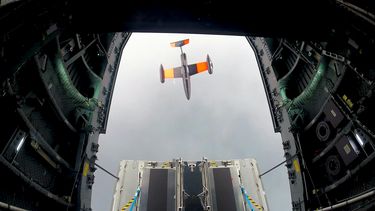
The A400M as a mothership for drones: This capability was successfully tested at the end of 2022.
Ready for electronic combat
Electronic warfare has become a cornerstone of modern defence strategy. On the one hand, this involves sophisticated self-protection systems for the platforms deployed; on the other, it revolves around applying active jamming capabilities to neutralise enemy air defences or drones. The A400M is already equipped with a variety of state-of-the-art self-defence mechanisms. And it will become even safer: Airbus will equip 23 A400Ms of the German Air Force with DIRCM protection systems, protecting them against infrared-guided missiles.
Regarding active jamming, the A400M could also be used as a stand-off jammer platform that operates outside of the contested airspace and can disable enemy systems from a safe distance. The A400M would be well suited for this critical role for several reasons:
- Structural readiness: To cover the role of a stand-off jammer, the aircraft must carry a high number of antennas. The A400M offers enough space to accommodate all of them.
- Sufficient power supply: The A400M's four engines and generators provide sufficient electrical power.
- Versatility: The stand-off jammer role fits seamlessly into the A400M's operational profile, complementing its other core capabilities, such as airlift, air-to-air refuelling, and medical evacuation.
- Acting as a receiver: The aircraft's ability to be refuelled in the air makes it ideal for extended jamming missions.
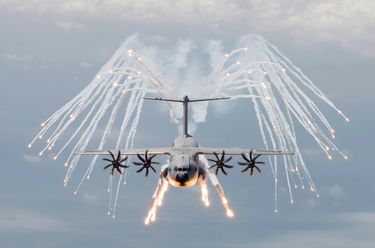
While the A400M already incorporates a number of countermeasures, including chaff and flares, these will be enhanced by the addition of DIRCM protection systems, which will protect the aircraft against infrared-guided missiles.
Fighting the flames
Wildfires are a serious global threat, devastating ecosystems and endangering lives. Advanced firefighting solutions are greatly needed, and the A400M is up to the challenge.
Airbus is developing a roll-on/roll-off firefighting kit for the A400M that does not require any modifications to the aircraft itself. This means that any A400M in a fleet could be swiftly converted into a firefighting aircraft. The kit enables the aircraft to deliver 20,000 litres of water or retardant in a single drop, creating high concentration lines of up to 400 metres in length. Combined with its ability to operate from short and unpaved runways, this capability could transform the way fires in remote or hard-to-reach areas are tackled.
The firefighting kit is currently in a prototyping phase. It has already been tested in Spain.

The A400M as a firefighting aircraft - this capability is currently being tested.
Heading into the future
The continued development of the A400M is in full swing. At the end of 2024, Europe’s Organisation for Joint Armament Cooperation (OCCAR) — an international organisation that manages the A400M programme on behalf of the launch customer nations — agreed with Airbus on the Block Upgrade 0. This upgrade will involve improvements to key elements of the A400M's systems, including tactical information enhancements and the implementation of a satellite-based landing system. It will also ensure the A400M fleet fully complies with the latest NATO requirements.
The A400M already boasts numerous key capabilities today that make it an indispensable tool in operations. A continuous flow of targeted enhancements will ensure that it remains at the cutting edge of technology in the future as well.
Latest Defence news
Continue Reading

Spain orders 18 C295 transport aircraft
Press Release
Defence
The Spanish Ministry of Defence has acquired 18 Airbus C295 transport aircraft to replace the CN235 and C212 fleets of the Spanish Air and Space Force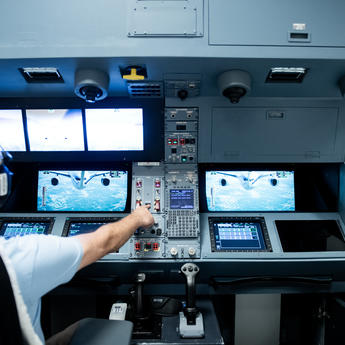
International Training Centre: 15 years training the world's best military crews
Web Story
Defence

Airbus A400M: Landing where others can't to deliver more aid
Web Story
Defence

Combating information warfare: How Airbus is helping win the fight for the truth
Web Story
Defence
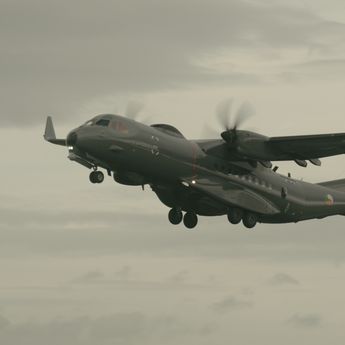
Airbus C295: How Ireland’s eyes in the skies help prevent illegal fishing
Web Story
Defence
